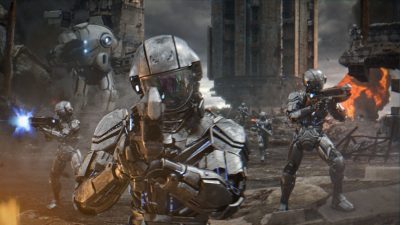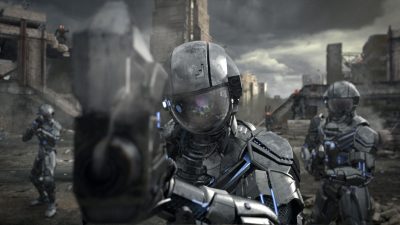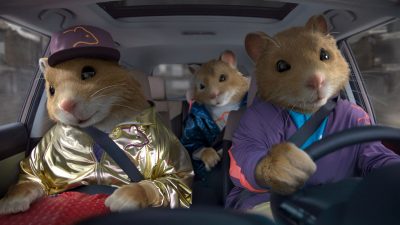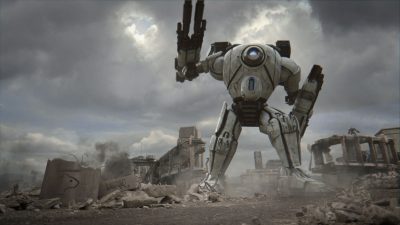A group of hipster hamsters take on a robot army, and a lone warrior has her own robot battle, in two recent and very epic commercials for KIA and Verizon with visual effects by Method Studios in LA. We talk to VFX supervisor Sean Faden about how the spots were created.
‘More Soul’ – KIA
“It was basically Halo versus Hamsters”
Continuing the involvement of KIA’s popular hamsters from previous commercials, ‘More Soul’ has the hip rodents engage in a dance-off with a robot army to promote the KIA Soul. The spot, directed by Mark Romanek for agency David & Goliath and production company Anonymous Content, debuted during the 2011 MTV Video Music Awards and features LMFAO’s club song, ‘Party Rock Anthem’.
 To achieve the ambitious visual effects – including full CG environments, robot dancers, hamster heads and arms and other effects over 36 shots – Romanek called on senior VFX supe Brad Parker, who worked with Method supervisors Nordin Rahhali and Sean Faden, and relied on extensive previs completed by Pixel Liberation Front.
To achieve the ambitious visual effects – including full CG environments, robot dancers, hamster heads and arms and other effects over 36 shots – Romanek called on senior VFX supe Brad Parker, who worked with Method supervisors Nordin Rahhali and Sean Faden, and relied on extensive previs completed by Pixel Liberation Front.
The spot features a robot battle interrupted by the hamsters arriving in their KIA Soul, leading to the dance-off. “It was basically Halo versus hamsters,” says Method’s Sean Faden, referring to his studio’s earlier work on the Halo: Reach ‘Deliver Hope’ spot which was supervised by Method creative director Dan Glass, who also helped where needed on ‘More Soul’. “It was also basically a music video,” adds Faden, “and Mark Romanek knows music videos and didn’t want to leave that up to chance.”
Production filmed for three days with ‘human’ hamster dancers, via choreographers Rich & Tone, wearing padded clothing and cage helmets and gloves fitted with tracking markers. “We shot on a stage in a hangar at Playa Vista where they filmed the Avatar motion capture,” says Faden. “Last time I was there that’s where they shot the main 25 foot miniature for Titanic.”
 “They had a lot of dirt and debris and rubble that the set dressers would keep moving around in a 40 foot square area on a concrete floor to try and make it feel like a different area,” adds Faden. “The car was always real, but we had to create some V-Ray-generated reflections to help it sit in the environment. We’d track the car and render some additional reflections of the CG environment to mix in.”
“They had a lot of dirt and debris and rubble that the set dressers would keep moving around in a 40 foot square area on a concrete floor to try and make it feel like a different area,” adds Faden. “The car was always real, but we had to create some V-Ray-generated reflections to help it sit in the environment. We’d track the car and render some additional reflections of the CG environment to mix in.”
A survey station and tracking markers were utilized on set, while C-stands stood in for the robots that would be added later in CG. “Every time we did a shot we would also consult the previs,” notes Faden. “Mark would change a shot here or there, he might adjust the lens, but it was pretty remarkable how close we stayed, and having the previs helped us stay on target and march through each set-up.”
An additional day of shooting also took place in the desert near Palmdale, California for the final exterior car driving scenes. “They used a Russian arm stabilized car to car crane for dynamic shots there,” says Faden. “And they had a Chapman crane that went up really high to get the final shot. I think they still ended up matte painting and extending that to make it feel even wider at the end of the day.”
 Back at Method Studios, visual effects supervisor Nordin Rahhali co-ordinated the majority of the post process. Motion-capture for the hamsters and robots was carried out by House of Moves, with matchmoving in SynthEyes, 3D Equalizer and Maya, and final animation completed in Maya and rendering in RenderMan. Compositing took place in Nuke and Flame.
Back at Method Studios, visual effects supervisor Nordin Rahhali co-ordinated the majority of the post process. Motion-capture for the hamsters and robots was carried out by House of Moves, with matchmoving in SynthEyes, 3D Equalizer and Maya, and final animation completed in Maya and rendering in RenderMan. Compositing took place in Nuke and Flame.
The hamster fur came together in Houdini, led by CG supervisor Andy Boyd, and was rendered in Mantra. “At one time they asked if we could create their pants and clothing in CG, but in the schedule we just didn’t have the time,” says Faden. “The minute you talk about replacing jackets and pants, it becomes feasible to say, ‘why don’t we just adjust their dance moves too?’ We did end up replacing the hat and a hood with CG ones, though.”
Effects work for the spot was extensive – made up of blasts from the black alien guns, smoke and dust for explosions, a light show that comes out of the bottom of the alien mothership, and dust off the feet of the bots as they’re dancing. “There’s also this beautiful almost slow-motion falling ash that pervades the whole spot,” recalls Faden. “And there are missile trails. All of that was done in Houdini.”
The wasteland backgrounds were a combination of CG renders and matte paintings painted on top and re-projected onto geometry, as Faden explains: “They had a few hero angles and would create lower-rez geometry that represented all that, then render a nice occlusion pass which gave the matte painters a great template to paint on. They had the perspective and scale right and shadowing, and then they were able to paint over source imagery while staying true to the correct perspective.”
 Method visual effects credits for ‘More Soul’
Method visual effects credits for ‘More Soul’
Senior VFX Supervisor/Creative Director: Dan Glass
VP, Production/Senior Executive Producer: Gabby Gourrier
VFX Supervisors: Nordin Rahhali and Sean Faden
VFX Producer: Mike Wigart
CG Supervisor: Charles Abou Aad
CG Supervisor (Hamsters): Andy Boyd
Animation Supervisor: Mike Warner
Compositing Supervisor: Chris Bankoff
Lighting Lead: Matthew Maude
Flame Lead: Noah Caddis
___________________________
‘Arena’ – Verizon
The equally ambitious ‘Arena’ spot for Verizon, showcasing Motorola’s Droid Bionic, tail-ended Method’s work for the ‘More Soul’ TVC. Directed by Noam Murro of Biscuit Films for agency mcgarrybowen, the Verizon commercial features a lone warrior battling three robots – an HDMI bot, a RAM bot, and a lightning-infused 4G bot. All of this occurs inside a giant futuristic arena nestled in the middle of a city metropolis.
“When she was hitting a robot she was either hitting a green punching bag or standing on the top third of a practically built version of the RAM bot”
Concepts for the arena were developed by Ev Shipard and Lubo Hristov, and for the RAM and HDMI bots by Legacy Effects and the 4G bot by Olivier Pron from Method’s London office. Halon Entertainment generated previs. “I came on after they shot the commercial,” says Method visual effects supervisor Sean Faden. “The on-set supervisor was Phil Brennan. They filmed the actress against greenscreen and a fairly small chunk of concrete floor. When she was hitting a robot she was either hitting a green punching bag or she was standing on the top third of a practically built version of the RAM bot.”
Method continued working on the designs of the robots, and also spent time post-viz’ing the action with animatics, led by animation supervisor Steward Burris. “One of the major challenges on this job was figuring out how to fit this battle in the edit,” explains Faden. “The edit was done with this girl battling a greenscreen – there really wasn’t much there. The other big challenge was the look of the arena, which was so subjective. It exists in every single shot and it had to photo-real, amazing and something no one’s ever seen.”
The arena was built inside Maya, with matte painted buildings in the background. But once the arena was rendered the team decided to add further details. “We had a couple of guys here – Matt Dessero, who’s another one of our supervisors, and Dan Glass, our senior creative supervisor – work with one of our matte painters Wei Zheng on the CG renders and dress them up with a few things like more detailed lights, more coloration and flaring.”
Volumetric elements for the arena were created in Houdini, and then composited in Nuke and Flame, under compositing supervisors Patrick Ferguson and Jeff Allen, as well as lead Flame Jonathan Lagache. “We knew we needed to do some nice atmosphere to help sell the scale,” notes Faden, “and get some good flaring of the lens as well as actual flaring of the actress.

“One of the challenges of shooting someone on a greenscreen is making them feel like they’re there,” continues Faden. “Of course when it was shot, nobody knew what this arena would look like and how many lights there would be. What helped us integrate her into the environment was that we had these giant vertical lights around the arena, and every time you saw one of these we flared out the foreground a little bit and washed the lights over her, which helped tie her in.”
Compositors created flares for every single light, including for the racks of 50 or 60 lights in the arena rafters. “We used Nuke to procedurally add these flares,” explains Faden. “We also added this band of undulating light that wraps around the whole arena – like a continuous LED light. Some people also looked at it and thought it looked like silhouetted people through a thin slit watching the action unfold.”
Adds Faden: “A lot of the tight shots we found we didn’t want to put too much atmosphere behind her because she had pretty rich blacks behind her and we found too much atmosphere separated her too much. The wider shots where you saw a lot more depth and volume of the arena, we made sure we added atmosphere to play up the distance between the action and the end of the arena.
The robots were built and animated in Maya, with the 4G bot representing the most challenges because of its lightning effects. “All the lightning was generated in Houdini,” says Faden. “We took the animation from Maya, imported that into Houdini and then had some procedural lightning elements that filled him up. The idea there was that we wanted it to always feel like it was flowing outward from his core – the 4G core. The client wanted to see more lightning, so we added this additional arcing lightning around his body – a thinner, finer lightning. We looked at a lot of Tesla coil footage for reference. We noticed it would have the main bolts and then thinner, finer tendrils that would arc and take different paths.”
“We exported the lightning from Houdini into Maya and rendered this in V-Ray”
During the battle, the 4G bot fires bolts of lighting at the challenger, made up of Houdini particulates, impact elements, trailing particulates and trailing smoke, plus the actual lightning bolt itself. “We exported the lightning from Houdini into Maya and rendered this in V-Ray,” says Faden. “We could have used Houdini, but because the V-Ray guys were using the lightning to light the metal of the robot, they used the lighting geometry to cast light. We also did a lot of compositing tricks on the final lightning to give it some glows and color variation.”
Other effects during the battle included breaking glass, sparks and a red-colored weapon. “There were a few sparks we could source from 2D libraries, but anything coming off of a moving object was created in 3D in Houdini,” says Faden. “We tracked her weapon in SynthEyes and Maya and then the actual elements were a combination of the compositor glowing roto for the tips, as well as CG plasma blades matching the red of her outfit. The fire bursts were 2D elements composited in. For the plasma blades, we used a subtle heat distortion around them which helped read the energy.”
In the end, Method created 60 shots for the 60 second ‘Arena’ spot (plus an additional 50 shots for the director’s 90 second version) over a three month schedule. Faden says that this commercial and KIA’s ‘More Soul’ were tough but rewarding VFX assignments from the beginning. “We were working on the designs of the robots for ‘Arena’, and the agency really liked it. They were actually using our concept renders for desktop wallpaper, so we knew we had something good!”
Method visual effects credits for ‘Arena’
Dan Glass – Senior Creative Director/Senior VFX Supervisor
Gabby Gourrier – Senior Executive Producer
Stephanie Gilgar – Head of Production
Krystina Wilson – Producer
Anastasia von Rahl – Coordinator
Phil Brennan – On Set VFX Supervisor
Sean Faden – VFX Supervisor
Michael-Sean Foley – CG Supervisor
Masa Narita – Modeling Supervisor
Alex Whang, Lim Bunupuradah, Toshiro Sakamati – Modeling
Brian Ripley, Josh Frontino –Texture
Fabio Zapata – On-set Tracking / Tracking Supervisor
Eugene Jeong, Briana Hamilton, Jesse Carlson – Rigging
Danny Garcia, Mike Maker, Tom Stanton, Sean Gray, Christina Boice, Luis Rodriguez – Tracking
Lauren Van Houten – Match Move
Wei Zheng – Matte Painting
Lubo Hristov – Matte Painting, Christov FX
Steve Viola – Matte Painting – Rok!t Studios
Khi Kim, Brett Angelillis, Karl Kohlman, Jeff Willette, Rachael Campbell – Houdini
Steward Burris – Animation Supervisor
Jonah Austin, Jordan Harris, John Nguyen, Aaron Schultz –Animation
Scott Metzger, Mike Dalzell, Daniel Buck, Chris Brown, David Lo – V-Ray
Patrick Ferguson / Jeff Allen –Compositing Supervisors
Dan Akers, Andy Mower, Krista Benson, Marc Nanjo, Sandro Blattner, Vinh Nguyen – Nuke
Jonathan Lagache – Flame
Eva Snyder, Pam Gonzalez, Patricio Fernandez, Mark Duckworth, Kenneth Lui – Roto / Paint

Pingback: [ 2011 kia soul commercial with robots ] Best Web Pages | (NetizenOpinion)
Pingback: [ 2011 kia soul commercial robots ] Best Web Pages | (NetizenOpinion)
Pingback: Thiết kế logo & bộ nhận diện thương hiệu, tờ rơi, túi giấy, card visit Điểm lại những TVC hay nhất năm 2011
Pingback: Kia Soul Hamster, de Method Studios - CICE